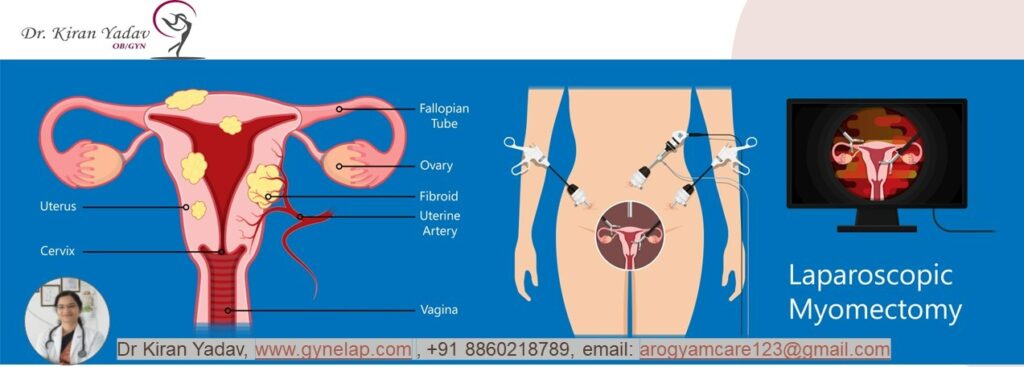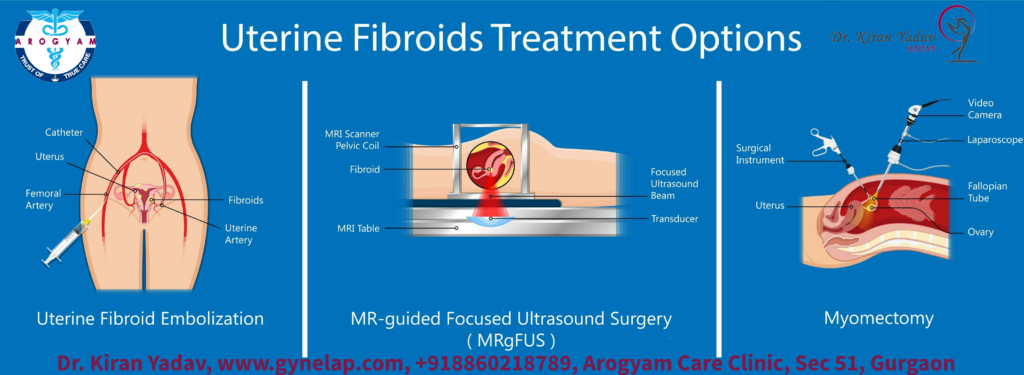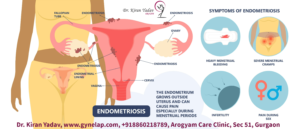Understanding Uterine Fibroid Treatment
Surgical treatment Options for Uterine Fibroid
When it comes to treating fibroids, surgery is often considered. The most common surgical options include:
- Myomectomy: Myomectomy is a surgical procedure aimed at removing fibroids while preserving the uterus. This is particularly beneficial for women who wish to maintain their fertility.
Types of Myomectomy:
- Hysteroscopic Myomectomy: Performed through the vagina and cervix using a hysteroscope. Ideal for fibroids located inside the uterine cavity.
- Laparoscopic Myomectomy: Minimally invasive surgery using small incisions and a laparoscope. Suitable for smaller and fewer fibroids.
- Robotic Myomectomy: minimal invasive approach utilizing robotic instruments.
- Abdominal Myomectomy: Involves a larger abdominal incision to remove fibroids. Used for larger or multiple fibroids.
When to Use: Myomectomy is recommended for women who experience significant symptoms from fibroids but wish to retain their uterus for future pregnancies12.
- Hysterectomy: In more severe cases, a hysterectomy, which is the removal of the uterus, may be recommended. This is a definitive solution but eliminates the possibility of future pregnancies. Hysterectomy can be done by laparoscopy or Robotic approaches in most of the cases.
When to Use: Hysterectomy is considered when fibroids cause severe symptoms, and other treatments have failed or are not suitable. It is also an option for women who do not wish to preserve fertility34.
Non Surgical Treatments for Uterine Fibroid
For those looking to avoid surgery, there are several non-surgical treatments available:
1. Uterine Fibroid AngiEmbolization (UFE)
Description: UFE is a minimally invasive procedure that involves blocking the blood supply to the fibroids, causing them to shrink.
Procedure: A catheter is inserted through the groin and guided to the uterine arteries. Tiny particles are injected to block the blood flow to the fibroids.
When to Use: UFE is suitable for women who want to avoid surgery and do not plan to become pregnant in the future. It is effective for reducing symptoms and shrinking fibroids.
2. MRI-Guided Focused Ultrasound Surgery (FUS)
Description: FUS uses high-intensity ultrasound waves to heat and destroy fibroid tissue.
Procedure: Performed under MRI guidance, this non-invasive technique targets fibroids with precision, minimizing damage to surrounding tissues.
When to Use: FUS is ideal for women seeking a non-invasive treatment option with minimal recovery time. It is not recommended for women who wish to conceive.
3. Radiofrequency Ablation (RFA)
Description: RFA uses radiofrequency energy to heat and destroy fibroid tissue.
Procedure: Performed laparoscopically or transcervically, RFA involves inserting a probe into the fibroid and applying radiofrequency energy to induce coagulative necrosis.
When to Use: RFA is suitable for women with symptomatic fibroids who prefer a minimally invasive option. It is not recommended for women planning future pregnancies.
4. Medications: “Certain medications can help manage symptoms and reduce fibroid size. These include hormonal treatments like GnRH agonists
Natural Treatments for Uterine Fibroid
- Diet and Lifestyle Changes
Description: Making specific dietary and lifestyle adjustments can help manage fibroid symptoms and potentially reduce their size.
Key Changes:
- Increase Anti-inflammatory Foods: Incorporate foods rich in antioxidants and anti-inflammatory properties, such as leafy greens, berries, nuts, and seeds.
- Reduce Red Meat and Alcohol: Limit consumption of red meat and alcohol, as they have been linked to an increased risk of fibroids.
- Maintain a Healthy Weight: Obesity is a risk factor for fibroids, so maintaining a healthy weight through diet and exercise can be beneficial.
When to Use: These changes are recommended for overall health improvement and can be particularly helpful for women with mild fibroid symptoms.
- Herbal Remedies
Description: Certain herbs are believed to help balance hormones and reduce fibroid size.
Common Herbs:
- Green Tea Extract: Contains epigallocatechin gallate (EGCG), which has been shown to reduce fibroid size and decrease blood loss during menstruation1.
- Vitex (Chasteberry): Known for its hormone-balancing properties, vitex can help regulate menstrual cycles and reduce fibroid symptoms
- Turmeric: Contains curcumin, which has anti-inflammatory and anti-tumor properties.
When to Use: Herbal remedies can be used as a complementary approach alongside other treatments. Always consult with a healthcare provider before starting any herbal supplements.
- Stress Management Techniques
Description: Managing stress through various techniques can help alleviate fibroid symptoms.
Techniques:
- Yoga and Meditation: These practices can help reduce stress and improve overall well-being.
- Mindfulness Practices: Techniques such as deep breathing and progressive muscle relaxation can help manage stress levels.
When to Use: Stress management techniques are beneficial for overall health and can be particularly helpful for women experiencing stress-related fibroid symptoms.
- Vitamin and Mineral Supplements
Description: Certain vitamins and minerals may help manage fibroid symptoms and support overall reproductive health.
Key Supplements:
- Vitamin D: Studies suggest that vitamin D may help reduce the risk of fibroid development.
- Iron: For women experiencing heavy menstrual bleeding, iron supplements can help prevent anemia.
When to Use: Supplements can be used to address specific deficiencies and support overall health. Always consult with a healthcare provider before starting any new supplements.










